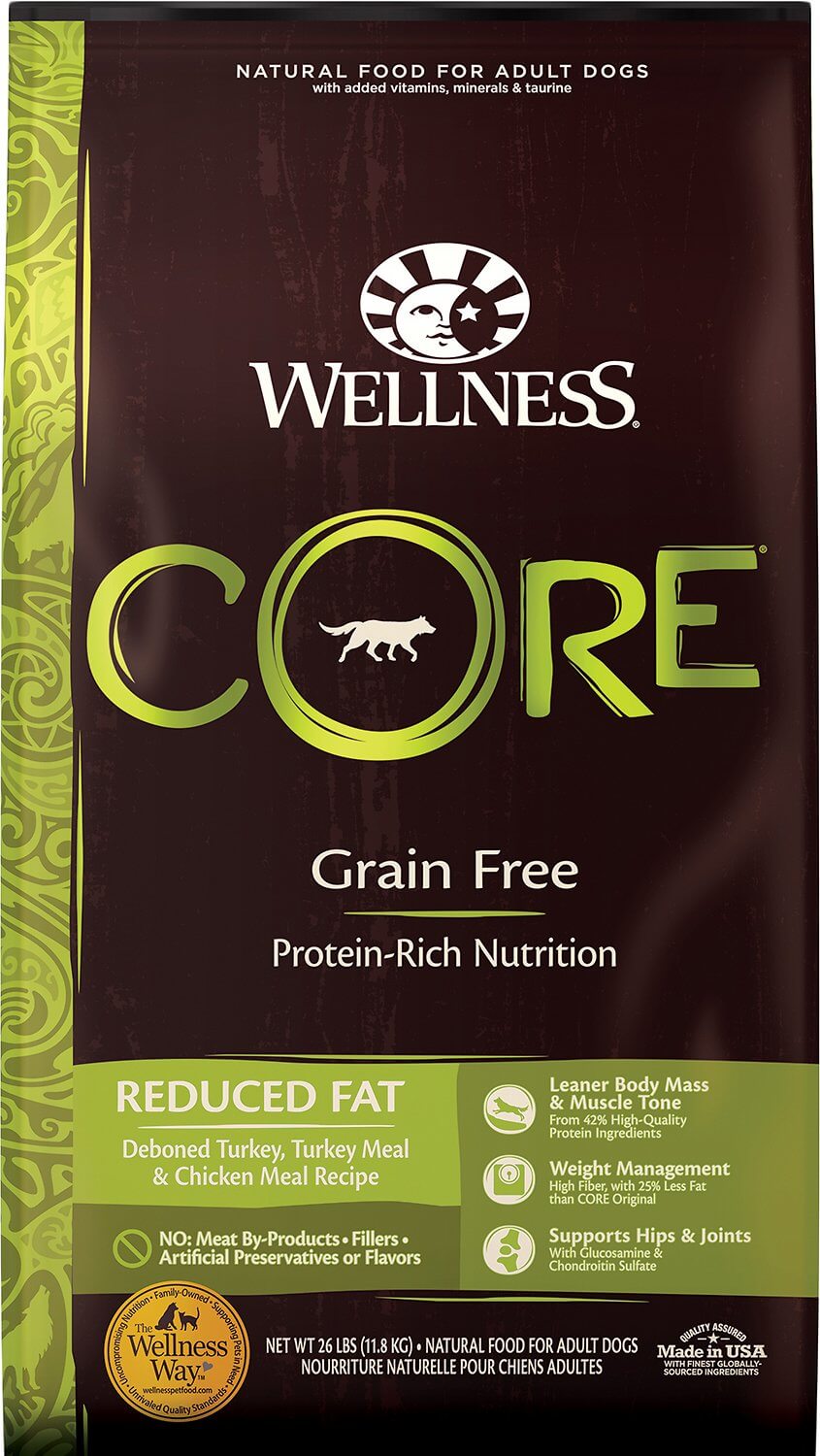
DogFoodAdvisor is reader supported See how
All reviews are 100% impartial but if you buy using links on this page, we may earn a referral fee.
Our Verdict
Wellness Core Reduced Fat Dog Food earns the Advisor’s top rating of 5 stars.
Wellness Core Grain Free Reduced Fat Weight Management Turkey and Chicken is the only recipe in the range. This recipe is claimed to meet AAFCO nutrient profiles for adult maintenance.
Wellness Core Grain Free Reduced Fat Weight Management Turkey and Chicken
Estimated Dry Matter Nutrient Content
Protein
Fat
CarbsCarbohydrates
Deboned turkey, turkey meal (source of glucosamine), chicken meal (source of chondroitin sulfate), lentils, peas, dried ground potatoes, pea fiber, ground flaxseed, tomato pomace, chicken fat (preserved with mixed tocopherols), natural chicken flavor, salmon oil, taurine, vitamin E supplement, choline chloride, spinach, broccoli, carrots, parsley, apples, blueberries, kale, zinc proteinate, mixed tocopherols added to preserve freshness, zinc sulfate, calcium carbonate, niacin, iron proteinate, ferrous sulfate, vitamin A supplement, copper sulfate, thiamine mononitrate, copper proteinate, manganese proteinate, manganese sulfate, d-calcium pantothenate, sodium selenite, pyridoxine hydrochloride, riboflavin, biotin, vitamin D3 supplement, chicory root extract, yucca schidigera extract, calcium iodate, vitamin B12 supplement, folic acid, ascorbic acid (vitamin C), dried lactobacillus plantarum fermentation product, dried enterococcus faecium fermentation product, dried lactobacillus casei fermentation product, dried lactobacillus
Fiber (estimated dry matter content) = 8.5%
Red denotes any controversial items
| Estimated Nutrient Content | |||
|---|---|---|---|
| Method | Protein | Fat | Carbs |
| Guaranteed Analysis | 33% | 10% | NA |
| Dry Matter Basis | 37% | 11% | 44% |
| Calorie Weighted Basis | 34% | 25% | 41% |
Ingredients Analysis
The first ingredient in this dog food is turkey. Although it is a quality item, raw turkey contains up to 73% water. After cooking, most of that moisture is lost, reducing the meat content to just a fraction of its original weight.
After processing, this item would probably account for a smaller part of the total content of the finished product.
The second ingredient is turkey meal. Turkey meal is considered a meat concentrate and contains nearly 300% more protein than fresh turkey.
The third ingredient includes chicken meal, another protein-rich meat concentrate.
The next two ingredients are lentils and peas. Lentils and peas are quality sources of carbohydrates. Plus (like all legumes) they’re rich in natural fiber.
However, they contain about 25% protein, a factor that must be considered when judging the meat content of this dog food.
The sixth item is dried ground potato, a dehydrated item usually made from the by-products of potato processing. In most cases, dried potato can contain about 10% dry matter protein which can affect our estimate of the total meat content of this recipe.
The seventh ingredient is pea fiber, a mixture of both soluble and insoluble dietary fiber derived from pea hulls. Aside from the usual benefits of fiber, this agricultural by-product provides no other nutritional value to a dog.
The eighth ingredient is flaxseed, one of the best plant sources of healthy omega-3 fatty acids. Provided they’ve first been ground into a meal, flax seeds are also rich in soluble fiber.
However, flaxseed contains about 19% protein, a factor that must be considered when judging the actual meat content of this dog food.
The ninth ingredient is tomato pomace. Tomato pomace is a controversial ingredient, a by-product remaining after processing tomatoes into juice, soup and ketchup.
Many praise tomato pomace for its high fiber and nutrient content, while others scorn it as an inexpensive pet food filler.
Just the same, there’s probably not enough tomato pomace here to make much of a difference.
The tenth ingredient is chicken fat. This item is obtained from rendering chicken, a process similar to making soup in which the fat itself is skimmed from the surface of the liquid.
Chicken fat is high in linoleic acid, an omega-6 fatty acid essential for life. Although it doesn’t sound very appetizing, chicken fat is actually a quality ingredient.
From here, the list goes on to include a number of other items.
But to be realistic, ingredients located this far down the list (other than nutritional supplements) are not likely to affect the overall rating of this Wellness product.
With five notable exceptions…
First, we find salmon oil. Salmon oil is naturally rich in the prized EPA and DHA type of omega-3 fatty acids. These two high quality fats boast the highest bio-availability to dogs and humans.
Depending on its level of freshness and purity, salmon oil should be considered a commendable addition.
Next, this recipe includes taurine, an important amino acid associated with the healthy function of heart muscle. Although taurine is not typically considered essential in canines, some dogs have been shown to be deficient in this critical nutrient.
Since taurine deficiency appears to be more common in pets consuming grain-free diets, we view its presence in this recipe as a positive addition.
In addition, chicory root is rich in inulin, a starch-like compound made up of repeating units of carbohydrates and found in certain roots and tubers.
Not only is inulin a natural source of soluble dietary fiber, it’s also a prebiotic used to promote the growth of healthy bacteria in a dog’s digestive tract.
Next, this recipe contains sodium selenite, a controversial form of the mineral selenium. Sodium selenite appears to be nutritionally inferior to the more natural source of selenium found in selenium yeast.
And lastly, this food includes chelated minerals, minerals that have been chemically attached to protein. This makes them easier to absorb. Chelated minerals are usually found in better dog foods.
Nutrient Analysis
Based on its ingredients alone, Wellness Core Reduced Fat looks like an above-average dry dog food.
The dashboard displays a dry matter protein reading of 37%, a fat level of 11% and estimated carbohydrates of about 44%.
And a fat-to-protein ratio of about 30%.
Which means this Wellness recipe contains…
Above-average protein. Below-average fat. And below-average carbs when compared to a typical kibble.
Even when you consider the protein-boosting effect of the lentils, peas, dried potato and flaxseed, this looks like the ingredient panel of a dry dog food containing a significant amount of meat.
Wellness Dog Food Recall History
The following automated list (if present) includes all dog food recalls related to Wellness through October 2024.
You can view a complete list of all dog food recalls since 2009 here.
Our Rating of Wellness Core Reduced Fat Grain Free Dog Food
Wellness Core Reduced Fat is a grain-free dry dog food using a significant amount of named meat meals as its dominant source of animal protein, thus earning the recipe 5 stars.
Compare Wellness Core Reduced Fat Dog Food
How does Wellness Core Reduced Fat compare with The Dog Food Advisor's most recommended brands?
A Final Word
The Dog Food Advisor does not accept money, gifts, samples or other incentives in exchange for special consideration in preparing our reviews.
However, we do receive a referral fee from online retailers (like Chewy or Amazon) and from sellers of perishable pet food when readers click over to their websites from ours. This helps cover the cost of operation of our free blog. Thanks for your support.
For more information, please visit our Disclaimer and Disclosure page.







